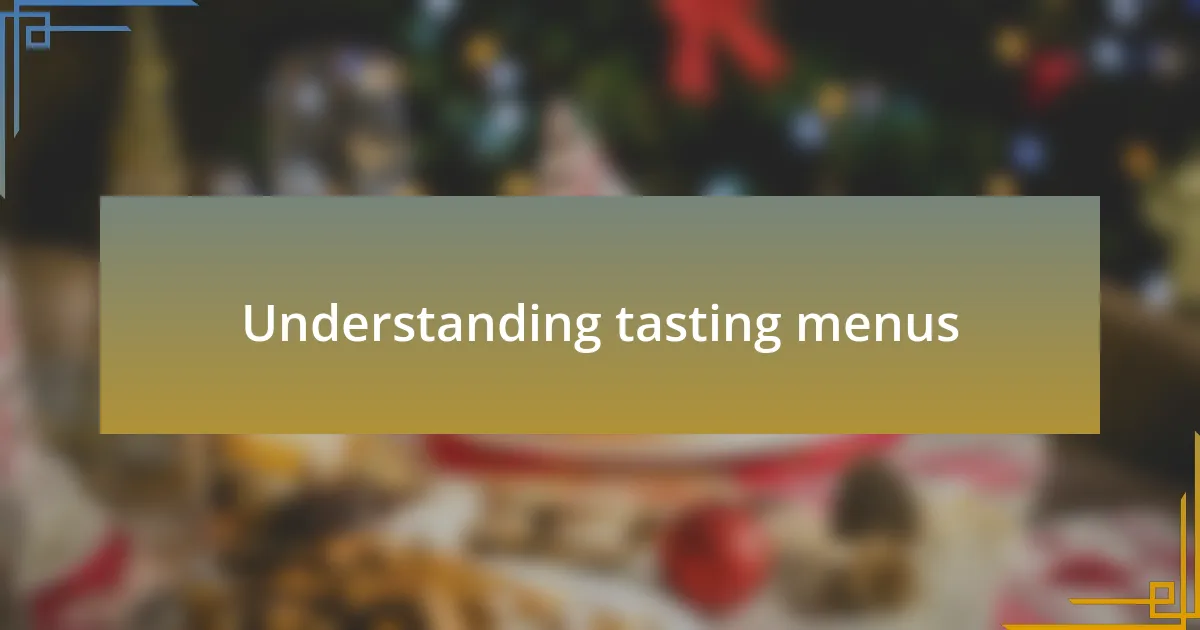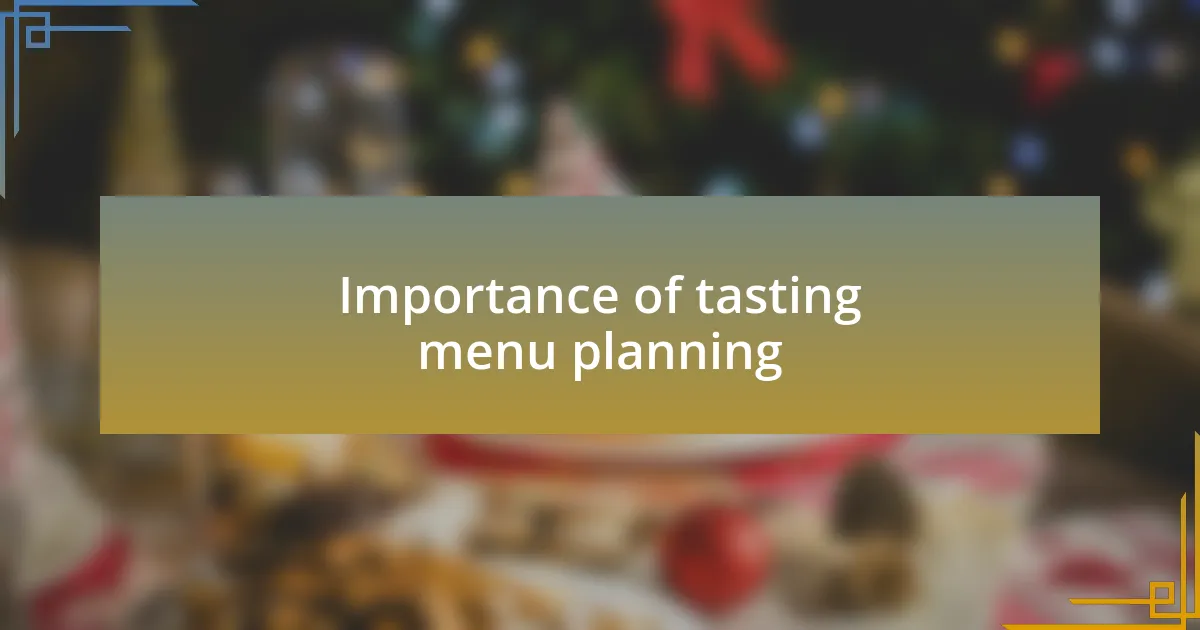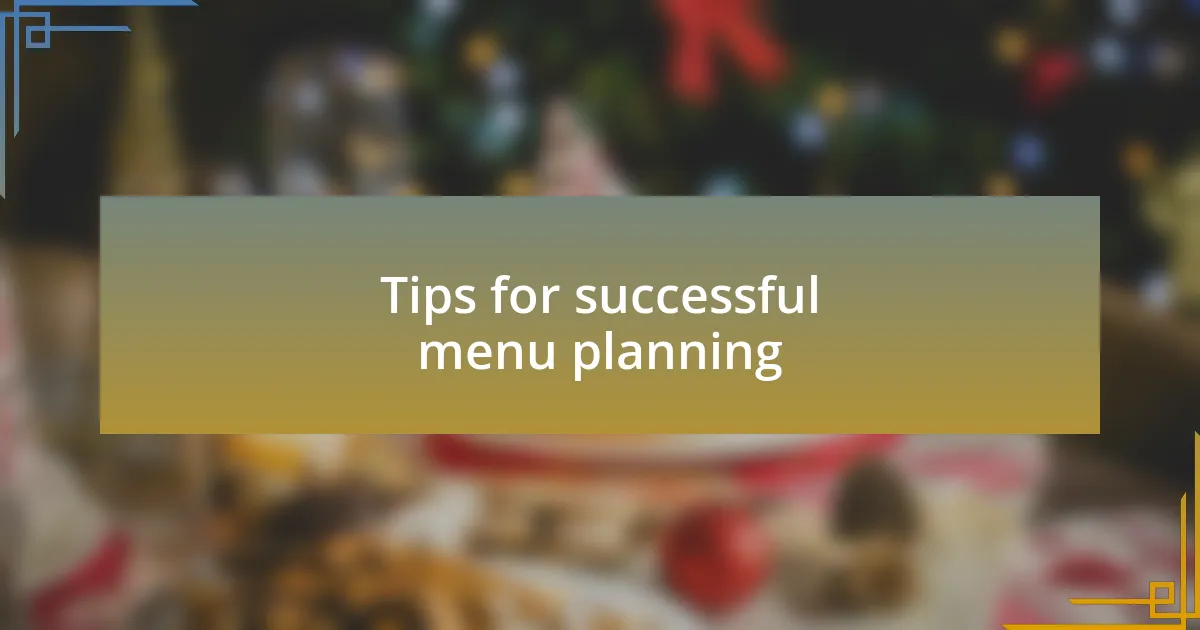Key takeaways:
- Tasting menus provide a unique culinary experience that reflects a chef’s creativity and can evoke shared memories among guests.
- Effective tasting menu planning includes understanding the couple’s story, proper pacing, and collaborating with skilled chefs to enhance the dining experience.
- Choosing the right caterer involves a personal connection and demonstrated experience, especially in managing dietary restrictions during weddings.
- Personalizing the tasting menu by incorporating family recipes, considering guests’ dietary needs, and focusing on presentation can create a memorable experience.

Understanding tasting menus
Tasting menus offer a unique culinary experience, providing a series of small, meticulously crafted dishes that showcase a chef’s creativity and skill. I remember attending a friend’s wedding where the tasting menu was a journey through local flavors, each bite sparking conversations among guests. It’s amazing how food can create shared moments, don’t you think?
The structure of a tasting menu often includes different courses, allowing diners to savor a range of textures and flavors, making it a delightful exploration for the palate. I once enjoyed a tasting menu that included a dish with unexpected elements—like a savory dessert that surprised my taste buds. This kind of innovation can provoke intrigue and excitement, adding a layer of fun to the dining experience.
Understanding the philosophy behind tasting menus can deepen appreciation for the meal. They are often designed to tell a story or convey a theme, reflecting the season or the chef’s personal journey. Have you ever noticed how a well-curated menu can elevate a celebration? It’s not just about the food; it’s about the emotions and memories tied to each dish.

Importance of tasting menu planning
Planning a tasting menu for a wedding is crucial because it sets the tone for the entire dining experience. I vividly recall curating a menu for my sister’s wedding, where we carefully selected each dish to reflect the couple’s journey together. That thoughtful process not only impressed the guests but also made the celebration feel more intimate and personal.
Each dish in a tasting menu serves as an opportunity to convey emotions and stories through flavors. I once witnessed a couple use family recipes as part of their tasting menu, which sparked nostalgia and connection among their loved ones. Have you ever felt how a familiar taste can transport you back to cherished memories? This emotional depth can turn a meal into a memorable experience.
Moreover, proper planning allows for accommodating dietary restrictions while ensuring guests feel catered to. At my own wedding, we included vegan and gluten-free options that delighted those who typically felt left out at such events. Thoughtful menu planning not only shows respect for guests’ needs but also demonstrates care and attention to detail, making them feel welcomed and valued.

Key elements of effective planning
Effective planning for a tasting menu hinges on understanding the couple’s unique story. I remember working on a menu for a close friend’s wedding, and we revolved each course around significant moments from their relationship, such as their first date or favorite vacation spot. It was incredible to see how the food could evoke laughter and nostalgia as they shared the stories behind each dish with their guests.
Another key element is timing and pacing. During one wedding I attended, the service was impeccable; each course arrived just as the previous one had been thoughtfully consumed. This rhythm kept the guests engaged and excited, enhancing the overall experience. Have you considered how the flow of meals might influence your celebration? A well-paced menu ensures the night feels lively and keeps conversations flowing seamlessly.
Lastly, collaboration with skilled chefs is essential. I once partnered with a talented chef who suggested unique pairings that transformed familiar flavors into culinary masterpieces. This creativity added elegance to the event. Engaging with culinary professionals can truly elevate a tasting menu, allowing for a dining experience that reflects both personal taste and stunning presentation.

Choosing the right caterer
Choosing the right caterer requires a blend of personal connection and quality assurance. I vividly recall selecting a caterer for my sister’s wedding; we met a chef who shared her passion for farm-to-table ingredients. Her enthusiasm was contagious and made us feel confident that she would create a menu reflecting our family’s values and tastes. Have you ever felt that spark when meeting someone who just gets it? That’s the kind of connection you should look for.
Moreover, it’s paramount to assess a caterer’s experience with wedding events specifically. I remember attending a wedding where the caterer seamlessly navigated dietary restrictions while still impressing every guest with their dishes. It not only spoke volumes about their proficiency but also showcased their ability to adapt and shine under pressure. Wouldn’t you want a caterer who can perform well in a busy, high-energy environment like a wedding?
Finally, don’t shy away from tasting sessions; they can be enlightening! I once visited a caterer who encouraged us to explore flavor profiles together, discussing each choice and its origin. This experience not only influenced our final selection but also deepened our understanding of the food itself. What could be more exciting than enjoying a meal that you’ve had a hand in curating, right?

Personalizing the tasting experience
Personalizing the tasting experience begins with understanding your preferences and those of your partner. I remember when planning my own tasting session, we brought our favorite flavors and dishes to the table. This led to an exciting discussion about how we could incorporate meals that held sentimental value, like my grandmother’s famous risotto. Have you ever thought about how food can evoke memories? It adds a layer of intimacy to the entire wedding experience.
Another crucial element in personalizing the tasting is considering your guests’ dietary needs. I once experienced a wedding where the couple ensured that gluten-free and vegan options were available, making everyone feel included. It was heartwarming to see the joy on those guests’ faces, knowing they could partake in the feast without worry. What a wonderful way to show your loved ones that you care about their comfort!
Finally, don’t underestimate the power of presentation in personalizing your tasting menu. While attending a friend’s wedding, I was captivated by how the appetizers were beautifully arranged to mirror the couple’s love for art. Each dish told a story, and it made the tasting memorable. How can you make your tasting experience visually stunning and reflective of your unique style? This approach not only elevates the dining experience but also reinforces the personal connections tied to your special day.

My favorite tasting menu ideas
One of my favorite tasting menu ideas revolves around the seasons. I vividly recall a wedding where each course celebrated the bounty of that time of year. Imagine indulging in a vibrant spring salad with edible flowers, followed by a warm, comforting dish featuring roasted root vegetables in the fall. The connection to the season can create a lovely atmosphere, don’t you think?
Another idea that resonates with me is featuring a travel-inspired tasting menu. I attended an event where every dish represented a favorite destination of the couple. The joy of savoring a Thai curry followed by an Italian risotto transported me around the world in just a few bites. It invites guests to share in the couple’s adventures, which is such a delightful way to reminisce. How would you bring your travels to life through food?
Lastly, I’ve always been fond of using family recipes to expand the tasting menu. At a wedding I went to, they paid homage to the couple’s heritage by serving dishes passed down through generations. It was more than just food; it was a celebration of family history and love. Wouldn’t it be wonderful to incorporate elements of your family’s culinary traditions into your wedding?

Tips for successful menu planning
When planning a successful tasting menu, consider the pacing of each course. I remember attending a wedding where the timing was impeccable, allowing guests to savor their meals without feeling rushed. It’s vital to leave enough time between courses for guests to enjoy conversation and absorb the experience. How would you want your guests to feel during the meal?
Another tip involves accommodating dietary restrictions. In my experience, I once witnessed a wedding where the couple thoughtfully included a vegan option that surprised and delighted several guests. It showed how much they cared about everyone at the event. How can you ensure that all your loved ones feel included in the celebration?
Don’t hesitate to incorporate a touch of personal flair into the tasting menu. I once tasted a unique twist on a traditional dish, where the couple added their signature spice blend to a classic recipe. It transformed the familiar into something extraordinary and memorable. What personal elements can you weave into your menu to make it truly yours?